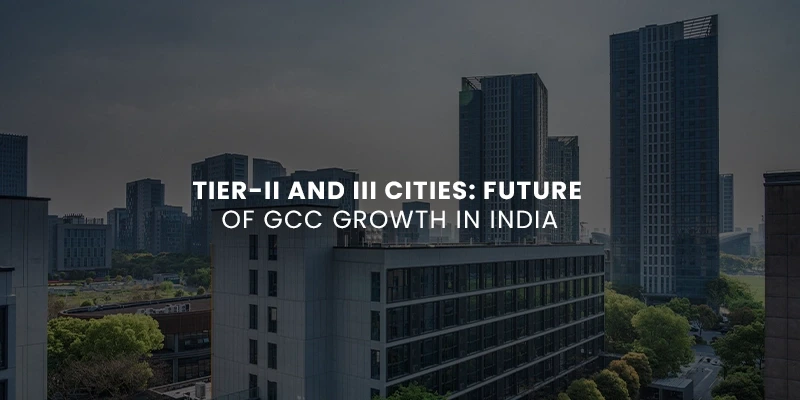Tier-II and III Cities: Future of GCC Growth in India
India’s journey as a global hub for Global Capability Centres (GCCs) has been nothing short of transformative. What began as an outsourcing story driven by cost savings in Tier 1 cities like Bengaluru, Hyderabad, and Mumbai has now evolved into a much broader ecosystem. Today, the new GCC policy framework and industry trends are reshaping the landscape, with Tier-II and III cities emerging as the next growth engines.
This shift highlights how India is moving beyond the traditional hubs to create a more inclusive, distributed model of growth. Supported by government initiatives, infrastructure development, and a rich talent pipeline, Tier-II and III cities are playing a central role in driving the future of GCCs in India.
The Growth Story of GCCs in India
India is currently home to over 1,700 GCCs, contributing billions to the economy and employing close to 2 million professionals.This highlights how GCCs in India have become a strategic move for multinational businesses, not just a cost-saving model also, the value of the sector is expected to surpass USD 100 billion by 2030; hence, GCCs are no longer synonymous with cost-reduction strategies but innovation strategy platforms through multinational corporates.
The evolution of GCCs is supported by forward-looking policies focused on decentralisation, skill development, and digital innovation. The impetus for GCC operation in small cities in India has been made possible through an incentive structure aligned to industry needs.
Why Tier-II and III Cities Are Gaining Momentum
Several factors explain why multinational companies are increasingly establishing their GCC operations in cities beyond the traditional metros:
- Economic Benefits: Talent and real estate costs in these cities are 40-60% lower than those in Tier 1 hubs.
- Vacant Skill Reservoirs: Universities and technical institutions in cities such as Coimbatore, Kochi, Indore, and Jaipur are continuously producing a stream of skilled graduates.
- Infrastructure Development: Smart city developments, improved connectivity, and IT parks are thus becoming attractive propositions for international businesses because they promised to be more alluring for foreign businesses.
- Higher Employee Retention: Employees, who are working closer to their hometown, tend to have a better loyalty, which will minimize attrition and add to the long-term stability.
- Policy Support: The new GCC policy has incentives for tax benefits, infrastructure grants, and easier approvals for expansion.
The Role of New GCC Policy
Under the new Global Capability Centres (GCC) policy released by the Ministry of Electronics and Information Technology (MeitY), India seeks to establish itself as a leader in high-value digital capabilities. The key objectives are as mentioned below:
- Encourage companies to open centres in Tier-II and III cities.
- Development of advanced skill sets in areas like Artificial Intelligence, healthcare technology, and analytics.
- Fiscal and research and development assistance for enhancing growth.
- Promote niche GCCs in new-age sectors like fintech, life sciences, and engineering.
The policy ensures a decentralized approach to growth whereby no smaller city in India will be left behind in its digital transformation journey.
The Hub-and-Spoke Model of Expansion
Many organisations are adopting the hub-and-spoke model for their GCC strategy. The main hub is retained in a Tier 1 city for strategic leadership and innovation, while Tier-II and III cities.
act as spokes for operational excellence. This structure allows businesses to combine the global connectivity of metros with the efficiency and cost-effectiveness of smaller cities.
It also helps reduce risks by diversifying operations across geographies and creates scalability by opening new avenues for expansion without overburdening Tier 1 ecosystems.
Impact on Workspaces and Local Economies
The expansion of GCCs into Tier-II and III cities has far reaching implications:
- Boost to Commercial real estate: There is a fast-raising demand for coworking spaces, IT parks, and flexible offices, and office space demand from GCCs has surged by 24% in FY25, underscoring the scale of expansion happening across India.
- Local Economic Strengthening: New job opportunities and investments are enhancing the economic profile of Tier-II and III cities.
- Cultural, Social Benefits: Reduced migration to metros will further enhance the quality of life for professionals who can now work closer to home.
Conclusion
As global businesses look to India not just for cost savings but also for innovation and scale, the role of Tier-II and III cities will continue to grow. With proactive GCC policies, government support, and the natural advantages of smaller cities, India is well-positioned to maintain its leadership in the GCC space.
For organisations planning to expand, these cities represent untapped opportunities—offering the perfect blend of affordability, talent, and growth potential. And with partners like
The Office Address, businesses can find the right workspaces to support their GCC journeys in these emerging hubs.
